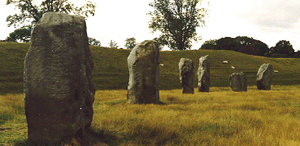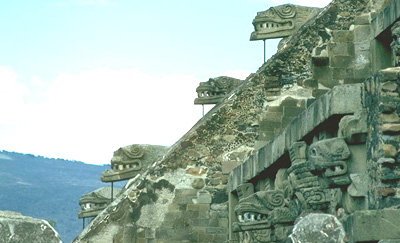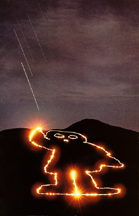News Archive of the Establishment of ISAAC,
the International Society for Archaeoastronomy
and Astronomy in
Culture
These articles all appeared in issues of the Archaeoastronomy & Ethnoastronomy Newsletter as calls to action and then announcements of the formation of the new international society.
Establishment of ISAAC
1996: Towards an International Organization
by Clive Ruggles and Stephen McCluskey
Those of us who study astronomies in cultures, whether under the heading of archaeoastronomy, ethnoastronomy, history of astronomy, or in broader disciplinary frameworks, have often sensed a certain lack of respect for our work from some of our colleagues who have followed well trodden and safer intellectual paths.
Among the reasons for this are that our studies have no single set of professional standards and there is no single disciplinary home where our work can be advocated. While we could all cite instances where work in "cultural astronomy" has proved immensely enlightening to mainstream archaeology, history, or anthropology, we have all equally well heard presentations under the banner of archeaoastronomy that, quite frankly, we would readily place beyond the lunatic fringe. There is also a great deal in between that, while perhaps representing competent enough scholarship, is not quite in tune with the deeper social or cognitive questions being addressed within the mainstream disciplines (see the article by Kintigh and the response by Aveni in earlier issues of A&E News). We may be able to look on different contributions with a suitably discerning eye, but all work in our field is often tarred with the same brush by our colleagues on the outside.
 Regular communication through meetings, journals, and newsletters such as this one have contributed greatly to the development of an internal sense of scholarly community and the professional standards that accompany such a community. Yet these are largely personal efforts, building on the labors of a few dedicated individuals, and have limited influence outside of our interdisciplinary community. Despite the years of shared scholarly activity since the pioneering meetings sponsored by the Royal Society and the British Academy meeting in London in 1972 and a year later in Mexico City by the AAAS and CONACYT, our community still lacks any lasting institutional basis to represent active scholars in the field and to advocate the significance of our work. Regular communication through meetings, journals, and newsletters such as this one have contributed greatly to the development of an internal sense of scholarly community and the professional standards that accompany such a community. Yet these are largely personal efforts, building on the labors of a few dedicated individuals, and have limited influence outside of our interdisciplinary community. Despite the years of shared scholarly activity since the pioneering meetings sponsored by the Royal Society and the British Academy meeting in London in 1972 and a year later in Mexico City by the AAAS and CONACYT, our community still lacks any lasting institutional basis to represent active scholars in the field and to advocate the significance of our work.
There are, of course, several regional and specialized societies touching on our field. Closest to our shared interests is the European Society for Astronomy in Culture / Société Européenne pour I'Astronomie dans la Culture (SEAC); broader in scope and national in membership are the Historical Astronomy Division of the American Astronomical Society, the History of Astronomy Interest Group of the History of Science Society, and the Working Group for the History of Astronomy in the Astronomische Gesellschaft. The closest thing to a worldwide international group has been the International Steering Committee for the "Oxford" Conferences, but the ISC has never been a membership organization.
Over the past few years, a number of us who felt the need for some form of international professional organization took initial steps to establish the International Society for Archaeoastronomy and Astronomy in Culture (ISAAC). The society's charter members are active participants in our discipline, and such active participation, as evidenced by published research, is the principal professional criterion for full membership in the society. We are currently acting to expand the society's membership beyond the initial small group of charter members, by inviting to full membership other actively publishing scholars in our community.
It seems appropriate at this early stage in the development of an international scholarly society, especially an interdisciplinary one, that we proceed slowly and deliberately. Current members are encouraged to nominate additional qualified candidates for full or associate membership, the latter being open to students and others having a serious interest in the study of astronomy in culture. Active or beginning scholars in the field who are interested in the society may contact the President, Clive Ruggles (School of Archaeological Studies, Leicester Univ., Leicester LE1 7RH England) or the Secretary/Treasurer, Stephen McCluskey (Dept. of History, West Virginia University, Morgantown, VIV, USA, 26506) .
This evolving society will work to enhance the professional status of our field by forming ties with existing international, regional, and national academic bodies, assisting the development of projects in cultural astronomy, organizing meetings, editing volumes of proceedings and books, and promoting the establishment and maintenance of a journal devoted to astronomy in culture in its widest sense.
As a first step in this direction, one largely due to the kind offer of John Carlson ind David Dearborn, A&E News will henceforth add ISAAC news and business to its existing coverage. It will also be circulated to ISAAC members, taking on an additional role as the Society's newsletter. A&E News will of course continue to be sent to its many individual and institutional subscribers who have expressed their long interest in archaeo- and ethnoastronomy.
1998: Introducing ISAAC to the Center for Archaeoastronomy
by David Dearborn and John B. Carlson
Archaeoastronomy lies between recognized disciplines. The parallax that this provides has permitted valuable new contributions to history, archaeology, astronomy and other formal areas of inquiry. Nevertheless, academics frequently look askance at archaeoastronomy as an endeavor. Many of us who have presented seminars or lectures at university campuses have heard "Your work is very solid, but those archaeoastronomers..."
 As Clive and Steve suggest in their essay, one reason for this distrust is that our studies have no professional advocacy, or disciplinary home. The establishment of the International Society for Archaeoastronomy and Astronomy in Culture (ISAAC) is an effort to construct such a home for the academic exercise of archaeoastronomy. By contrast, the Center for Archaeoastronomy has always been a subscription organization, dedicated to promoting research, education and public awareness of Archaeoastronomy and Ethnoastronomy, and building bridges of cooperation between professionals and amateurs alike. We will continue to pursue this mandate. For ISSAC, the goal is to promote standards of research and reporting that are as rigorous as those of any other professional society. As such, it is not an organization for everyone interested in archaeoastronomy, only those involved in the academic pursuit (particularly publication). Neither ISAAC nor the Center for Archaeoastronomy wish to exclude anyone from an interest in or the practice of archaeoastronomy. As Clive and Steve suggest in their essay, one reason for this distrust is that our studies have no professional advocacy, or disciplinary home. The establishment of the International Society for Archaeoastronomy and Astronomy in Culture (ISAAC) is an effort to construct such a home for the academic exercise of archaeoastronomy. By contrast, the Center for Archaeoastronomy has always been a subscription organization, dedicated to promoting research, education and public awareness of Archaeoastronomy and Ethnoastronomy, and building bridges of cooperation between professionals and amateurs alike. We will continue to pursue this mandate. For ISSAC, the goal is to promote standards of research and reporting that are as rigorous as those of any other professional society. As such, it is not an organization for everyone interested in archaeoastronomy, only those involved in the academic pursuit (particularly publication). Neither ISAAC nor the Center for Archaeoastronomy wish to exclude anyone from an interest in or the practice of archaeoastronomy.
In academic research, formal refereed publications are the measure of success, and will be the measure to participate in ISAAC. There are many subscribers to the journal who are not interested in such activities. Both we at the Center, and the founders of ISAAC, want everyone who has been and felt a part of archaeoastronomy to continue their diverse creative interests and affiliations. The establishment of ISAAC signals no imminent change in our editorial policies. At the Center for Archaeoastronomy, we have always tried to maintain a high standard for publication. ARCHAEOASTRONOMY has always been a refereed journal. This will not change. The acceptance of papers for publication has never been influenced by membership in any organization nor in degrees held by the author (a paper written by a Ph.D. is as easy to reject as one written by anyone else). We believe that the formation of ISAAC is a positive step for the field. It can promote an understanding of the questions and goals that have developed by people studying Archaeoastronomy and Ethnoastronomy, and demonstrate the formal rigor necessary for academic recognition.
One of the things that graduate school teaches (by fire) is how to construct an academically acceptable argument, and link one's research to generally understood questions of the field. Without such experience (and sometimes even with it), a student may fail to communicate the value of perfectly reasonable and innovative research. When we have received a manuscript that was not so constructed, we have tried to give the author suggestions on how to improve the manuscript. To the limit of time available, we intend this to continue.
Finally, ISAAC was born as a result of discussions by a small group. There was no initial attempt to involve many equally well qualified people. It is difficult to organize anything when too many people are involved. However, now, with a preliminary organizational structure established, it is time for ISAAC to grow, both in number and with new input, to evolve in form. At the Center for Archaeoastronomy, we consider this an important step forward in the development of Archaeoastronomy, and are proud to participate in ISAAC. A&E News will now serve both as the Quarterly Bulletin of the Center for Archaeoastronomy and for ISAAC.
1998: United We Stand: A New Arrangement
by John Carlson, David S. P. Dearborn, Stephen C. McCluskey, Clive L. N. Ruggles
For two decades, the Center for Archaeoastronomy has published the journal
Archaeoastronomy. It has served as an outlet for refereed articles studying
the practice, use, and meaning of astronomy in non-western cultural contexts.
A broad range of topics, including indigenous cosmologies, measurement systems,
calendrics, navigation, and even settlement planning, have found expression
under the headings of archaeoastronomy, ethnoastronomy, and history of
astronomy. During that period, the journal has evolved as this
interdisciplinary field matured. With the development of this newsletter to
provide timely information on new publications and conferences, the principal
task of the journal has become scholarly articles and book reviews.
 More recently, ISAAC, the International Society for Archaeoastronomy and
Astronomy in Culture, was established as a professional organization to promote
the academic development archaeoastronomy. The goal of this society is to
enhance the professional status of archaeoastronomy by forming ties with
existing international, regional, and national academic bodies, assisting the
development of projects in cultural astronomy, organizing meetings, and
promoting a journal devoted to astronomy in culture in its widest sense. This
last goal is being realized as ISAAC joins with the Center for the publication
of the journal Archaeoastronomy. More recently, ISAAC, the International Society for Archaeoastronomy and
Astronomy in Culture, was established as a professional organization to promote
the academic development archaeoastronomy. The goal of this society is to
enhance the professional status of archaeoastronomy by forming ties with
existing international, regional, and national academic bodies, assisting the
development of projects in cultural astronomy, organizing meetings, and
promoting a journal devoted to astronomy in culture in its widest sense. This
last goal is being realized as ISAAC joins with the Center for the publication
of the journal Archaeoastronomy.
Under this new arrangement, editorial duties will be divided among the four of
us, removing much of the burden from John's shoulders. Beginning early next
year, the labor will be further reduced as the University of Texas Press
becomes the Journal's contract publisher. Under UT press, the Journal will be
a semiannual with each issue containing 5 or 6 refereed articles of 10,000
words, and UT Press will asume layout, printing, and distribution
responsibilities for the publication. The annual cost of the Journal is
expected to rise from $36 to $40 for individual subscriptions, but this is a
very modest increase when balanced against the benefit of a regularly-appearing
journal.
With interest in archaeoastronomy ariseing from multiple disciplines, we will
continue to accept a broad range of articles. We will focus on high standards
of scholarship, as well as writing that is intelligible across the disciplinary
boundries. While we feel that the four of us provide a reasonable cross-
section representing disciplinary views, we are currently forming a board of
advisory editors to further assist us. We have begun soliciting this advisory
board from leading researchers in the fields of anthropology, archaeology,
astronomy and history. As the title implies these individuals will serve as
spokesmen for their disciplines, and provide guidance on the substance and
content of the Journal.
As the Journal already exists with a considerable subscription base, we are
maintaining the title, Archaeoastronomy, but adding a subtitle "The Journal of
Astronomy in Culture". The term archaeoastromy has occasionally been tarnished
through its association with marginal work, but it is an established term that
also encompasses interdisciplinary work of the highest scholarly standards.
With this journal, we intend to maintain a forum where researchers can find
high-quality articles of relevance to broader issues in a range of mainstream
disciplines.
While scholarship is important, it can not be an excuse to stifle controversial
ideas when they are based upon sound evidence and presented to academic
standards. Some papers may be provisionally accepted under the condition that
they be accompanied by an appropriate response. The advisory board will assist
us in deciding when such a response is important. We feel that such exchanges
will help our diverse community better understand the basis of and concerns
about new ideas.
In preparation for the first issue under the new arrangement (Vol 14, No 1), we
will be hard at work flogging John to finish Volumes 12 and 13. These volumes
will contain the long overdue papers from the First International Conference on
Ethnoastronomy and will be the last ones published independantly by the Center.
The first new issue will contain a number of solicited articles addressing
major themes, questions and issues in archaeoastronomy from a variety of
disciplinary perspectives. They will suggest new questions that set an agenda
for future research. The second issue of Volume 14 will also contain solicited
articles, this time with regional overviews. In Volume 15, we will resume
publishing submitted articles on a regular basis.
Together, the Center and ISAAC, with our new partners at UT Press hope that
this arrangement will improve the dissemination of information on
archaeoastronomy for the next 20 years, as well as providing a bridge between
disciplines.
|